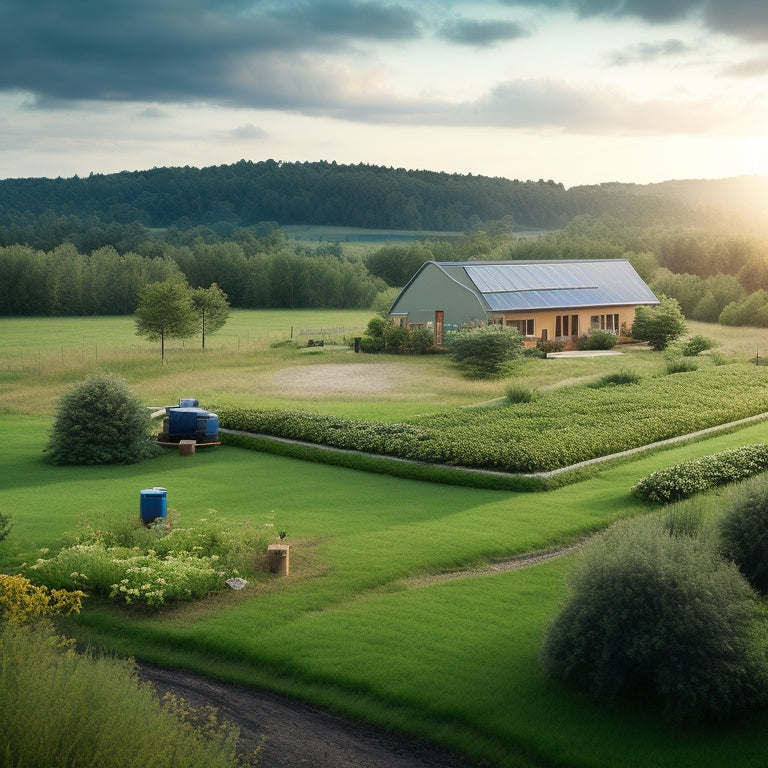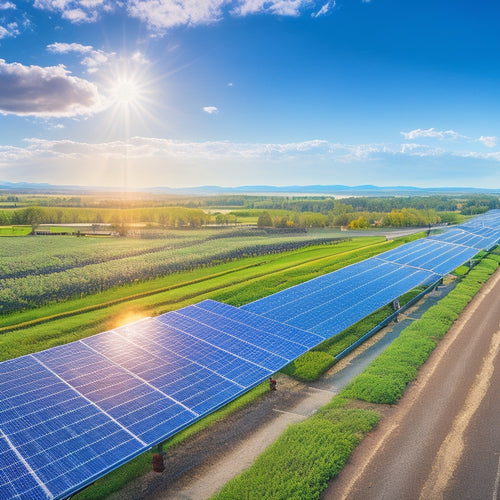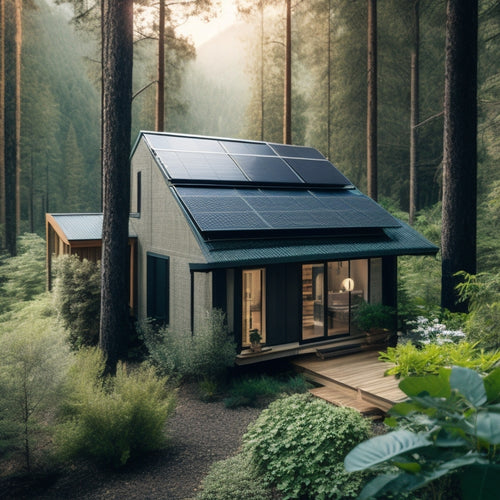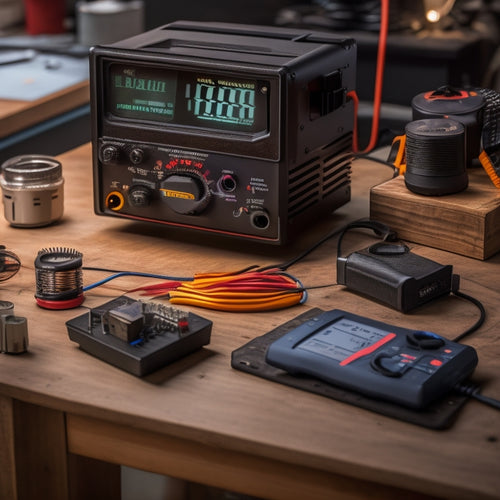
10 DIY Energy Solutions for Home Independence
Share
You're taking the first step towards energy independence by exploring DIY solutions that utilize renewable energy and reduce your reliance on traditional power sources. From cost-effective solar panel kits and affordable wind turbine options to energy-efficient water heaters and homemade biofuel solutions, there are numerous ways to power your home sustainably. You can also opt for small-scale hydroelectric power, energy harvesting window films, and DIY LED lighting upgrades to reduce your carbon footprint. By implementing these solutions, you'll not only lower your energy bills but also contribute to a greener future - and there's more to uncover as you continue on this path.
Key Takeaways
- DIY solar panel kits offer a cost-effective and eco-friendly energy solution for home independence, requiring regular maintenance and cleaning for optimal energy output.
- Affordable wind turbine options, such as vertical axis turbines, can generate small-scale energy in residential settings, depending on wind direction and topography.
- Small-scale hydroelectric power can be harnessed using micro hydro turbines, requiring accurate water flow rate assessments and durable materials for effective energy generation.
- Battery backup system designs, including battery management and cost analysis, can provide energy storage and management solutions for home independence.
- Energy-efficient solutions like LED lighting upgrades, energy-efficient water heaters, and homemade biofuel solutions can reduce energy consumption and promote sustainability in homes.
DIY Solar Panel Kits
With the cost of traditional energy sources skyrocketing and environmental concerns mounting, you're likely considering alternative solutions to power your home.
DIY solar panel kits offer a cost-effective and eco-friendly way to utilize renewable energy. These kits usually include pre-assembled panels, mounting hardware, and an inverter, making solar panel installation a relatively straightforward process.
When choosing a kit, consider factors such as wattage, voltage, and compatibility with your existing electrical system high-efficiency kits, as this will impact your overall energy savings.
It's crucial to verify proper solar panel maintenance to maximize energy output. Regularly cleaning the panels and monitoring their performance can help you identify any issues early on.
Additionally, consider factors like roof size, orientation, and local building codes before initiating your DIY solar project.
Portable Power Station Essentials
Beyond the domain of solar panels, portable power stations offer a versatile solution for your energy needs. When choosing a portable power station, consider the following essentials:
- Capacity and Power: Look for a station that can handle your energy requirements. Check the wattage and capacity to guarantee it can power your devices.
With the ability to reduce operational costs by up to 90% cost-effective solution, portable power stations can be a transformative solution for those seeking energy independence.
- Battery Type and Life: Choose a station with a reliable battery type, such as lithium-ion, and consider the lifespan and recharge cycles.
Since portable solar panel chargers are designed to be lightweight and compact unparalleled convenience, they can be easily taken on outdoor excursions.
- Portability and Durability: Select a station that's lightweight, compact, and rugged enough to withstand outdoor use.
Affordable Wind Turbine Options
You've investigated portable power stations as a reliable energy solution; now, let's employ the power of wind to further reduce your reliance on the grid. Affordable wind turbine options are more accessible than you think.
Consider a vertical axis wind turbine, which is quieter and more compact than traditional horizontal axis turbines. Perfect for small-scale energy generation, these turbines are ideal for residential use. Look for turbines with a small footprint and low noise output, making them suitable for urban or rural installations.
As you examine wind energy solutions, keep in mind that siting based on prevailing wind direction and topography affects turbine efficiency and energy output.
Did you know that offshore wind farms are becoming increasingly popular? While you mightn't be able to install an offshore turbine at home, you can replicate the concept on a smaller scale.
Investigate affordable wind turbine options that can help you tap into the power of wind and take another step towards energy independence.
Energy Efficient Water Heaters
As you work towards energy independence, don't overlook the humble water heater, which accounts for nearly 15% of your home's energy consumption. Upgrading to an energy-efficient water heater can make a significant impact on your energy bills and carbon footprint.
Consider the following options:
- Tankless water heaters, which heat water only as needed, reducing standby heat loss.
- Solar thermal systems, which utilize the sun's energy to heat water, providing a renewable energy source.
- Heat pump water heaters, which use heat from the air to heat water, offering high efficiency and low emissions.
Additionally, implement smart water monitoring to detect leaks and optimize water usage.
Insulation improvements and eco-friendly fixtures can also contribute to water conservation.
Regular water heater maintenance and energy audit tools will help you identify areas for improvement.
Homemade Biofuel Solutions
You can turn waste into energy by converting organic materials like food scraps and yard trimmings into biofuels.
By refining vegetable oil, you can create a sustainable fuel source for your home.
Now, let's investigate different biodiesel production methods that allow you to utilize this energy potential.
Waste to Energy Conversion
Waste management is a significant concern for many households, with organic waste being a substantial contributor to greenhouse gas emissions.
You can take control of your waste management by implementing sustainable practices that reduce your environmental impact.
Here are 3 ways to convert waste to energy:
-
Composting systems: Break down organic waste into nutrient-rich soil that can power your garden, reducing your carbon footprint and reliance on synthetic fertilizers.
-
Biogas production: Capture the energy potential of food waste and agricultural byproducts to produce biogas, a renewable resource that can power your home.
-
Recycling technologies: Employ innovative recycling technologies that convert waste into energy, reducing the need for landfills and supporting energy policies that prioritize sustainability.
Vegetable Oil Refining
Three liters of used vegetable oil can be refined into a liter of homemade biofuel, providing a sustainable alternative to fossil fuels.
You'll need to collect and sort used vegetable oil from local restaurants, cafes, or food establishments, ensuring it's free from contaminants. Effective vegetable oil sourcing is essential for a successful refining process.
Next, you'll need to implement proper oil filtration techniques to remove impurities and water. This can be done using a series of filters, including a coffee filter, cheesecloth, and a micron filter.
Biodiesel Production Methods
As you investigate the world of homemade biofuel solutions, biodiesel production methods emerge as a viable alternative to fossil fuels.
Biodiesel feedstock selection is critical, as it affects the quality and efficiency of the final product. You'll need to choose a suitable feedstock, such as vegetable oil or animal fat, and ascertain it's properly processed and filtered.
To get started, you'll need the right biodiesel production equipment, including:
- Reactor vessel: A container where the transesterification reaction takes place.
- Heat source: A device that maintains the required temperature for the reaction.
- Separation equipment: A system that separates the biodiesel from glycerin and other byproducts.
DIY Geothermal Heating Systems
You've likely heard of geothermal energy, but did you know you can employ it to heat your home without breaking the bank? A DIY geothermal heating system is a cost-effective and environmentally friendly way to warm your home. The system works by circulating a fluid through a geothermal loop, which is buried underground, and then using a heat pump to transfer the heat to your home.
| Component | Description | Cost |
|---|---|---|
| Geothermal Loop | Underground pipes that circulate fluid | $3,000 - $5,000 |
| Heat Pump | Transfers heat from loop to home | $2,000 - $3,000 |
| Pump and Controls | Circulates fluid and monitors system | $1,000 - $2,000 |
| Installation | Labor costs for setting up the system | $2,000 - $4,000 |
Small Scale Hydroelectric Power
You're likely wondering if your nearby stream or river can generate electricity for your home.
To get started, you'll need to assess the water flow rate to determine how much power you can realistically produce.
Next, you'll build a micro hydro turbine and capture the river energy to generate electricity.
Assessing Water Flow Rate
To harness the power of small-scale hydroelectricity, you need to determine the water flow rate at your potential hydro site. This involves measuring the volume of water flowing through your stream or river per unit of time.
To do this, you'll need to calculate the flow rate in liters per second (L/s) or gallons per minute (GPM).
Here are three essential steps to assess water flow rate:
-
Measure the channel width and depth: Record the width and average depth of your stream or river to calculate the cross-sectional area.
-
Measure the water velocity: Use a flow meter or a stopwatch to measure the time it takes for a float to travel a certain distance, then calculate the velocity.
-
Calculate the flow rate: Multiply the cross-sectional area by the velocity to get the flow rate in L/s or GPM.
Building Micro Hydro Turbine
As you've determined the water flow rate at your hydro site, it's time to employ that power by building a micro hydro turbine, a cost-effective and environmentally friendly way to generate electricity.
When designing your turbine, prioritize flow optimization and energy efficiency to maximize power output. Choose materials that guarantee durability and low maintenance, such as stainless steel or fiberglass.
Follow a thorough installation guide to confirm proper setup and minimize environmental impact. Conduct a cost analysis to determine the feasibility of your project.
Regularly monitor your turbine's performance to identify areas for improvement. By considering these factors, you'll be well on your way to utilizing the power of water and achieving energy independence.
Harnessing River Energy
River currents hold immense power, and exploiting this energy can be a revolutionary development for those seeking home independence.
If you're lucky enough to have a river nearby, you can tap into this energy source with small-scale hydroelectric power. To utilize river energy effectively, you need to understand river flow characteristics and turbine placement strategies.
Here are three key considerations for exploiting river energy:
-
Assessing river flow: Measure the river's flow rate, head, and velocity to determine the amount of energy you can generate.
-
Choosing the right turbine: Select a turbine design that suits your river's flow characteristics and energy output requirements.
-
Optimizing turbine placement: Position your turbine in a location that maximizes energy capture while minimizing environmental impact.
Energy Harvesting Window Films
Frequently, homeowners overlook their windows as a potential source of renewable energy. However, with energy harvesting window films, you can turn your windows into mini power plants. These innovative films integrate solar window technology, allowing you to generate electricity while still maintaining transparency and visibility.
| Energy Film Applications | Benefits |
|---|---|
| Building-integrated photovoltaics (BIPV) | Generates electricity while serving as a building envelope material |
| Solar windows for homes | Captures energy while providing natural light and insulation |
| Energy-efficient glazing | Reduces heat transfer and energy consumption |
| Smart windows with energy storage | Stores excess energy for later use |
DIY LED Lighting Upgrades
Your home's lighting system is one of the easiest and most impactful areas to upgrade for energy independence.
By switching to energy-efficient LED bulbs, you can considerably reduce your energy consumption and carbon footprint.
Here are three DIY LED lighting upgrades you can implement:
-
Ambient Lighting Design: Install LED strip installations under cabinets or in corners to create a warm and inviting ambiance while reducing energy consumption.
-
Smart Lighting Solutions: Replace traditional light switches with DIY light dimmers and smart lighting control systems to optimize energy usage and create a more sustainable lighting practice.
-
LED Color Temperature: Experiment with different LED color temperatures to find the perfect tone for your space, from warm whites to cool blues, and enjoy the benefits of energy-efficient lighting.
These DIY LED lighting upgrades won't only reduce your energy bills but also contribute to a more sustainable future.
Battery Backup System Designs
By the time you've optimized your lighting system, you're likely thinking about how to take your energy independence to the next level. A battery backup system is an essential step in this process.
When designing your system, consider battery management and inverter selection to guarantee efficient energy storage. System integration is key, so think about how your battery backup will work with your existing energy sources.
Don't forget safety considerations, like proper ventilation and electrical protection. Maintenance tips, such as regular battery checks, will help extend the life of your system.
Perform a cost analysis to determine the best solution for your budget. Follow installation guidance carefully, and consider performance monitoring to track your energy usage.
Frequently Asked Questions
How Much Maintenance Is Required for DIY Energy Systems?
You'll need to commit to regular maintenance to guarantee your DIY energy system's longevity; create a schedule to check and replace components, clean panels, and inspect wiring to keep your system running efficiently and effectively.
Are Energy-Harvesting Solutions Compatible With Existing Infrastructure?
Ha! You think the energy grid is a mess? Wait till you try to integrate your DIY energy-harvesting solutions! But seriously, you'll be relieved to know that most energy-harvesting solutions are designed to seamlessly integrate with existing infrastructure, enhancing energy efficiency and yielding impressive cost savings.
Can I Install DIY Energy Solutions in Rental Properties?
Before installing DIY energy solutions in a rental property, you'll want to review your rental agreements and understand your tenant rights to guarantee you're not violating any terms, and get landlord approval to avoid potential disputes.
What Kind of Permits Do I Need for DIY Energy Installations?
Like a chef needs a recipe, you'll need the right permits for your DIY energy installation. Check with your local government for specific permits required, as they vary, and follow installation guidelines to guarantee a smooth, sustainable process.
How Do I Ensure DIY Energy Systems Are Safe for My Family?
You guarantee DIY energy systems are safe for your family by following manufacturer instructions, conducting regular maintenance, and installing protective devices; prioritize system safety to confirm family protection from electrical shock, fire hazards, and other risks.
Related Posts
-

Applications of Photovoltaic Systems
Photovoltaic systems are versatile, converting sunlight into electricity for various applications. You can use them i...
-

Off Grid Solar Batteries
As you shift to off-grid living, you'll rely on high-performance solar batteries to store excess energy generated by ...
-

Key Features of a DC to AC Converter
A DC to AC converter features high efficiency and conversion rates, which reduce energy costs and improve performance...


